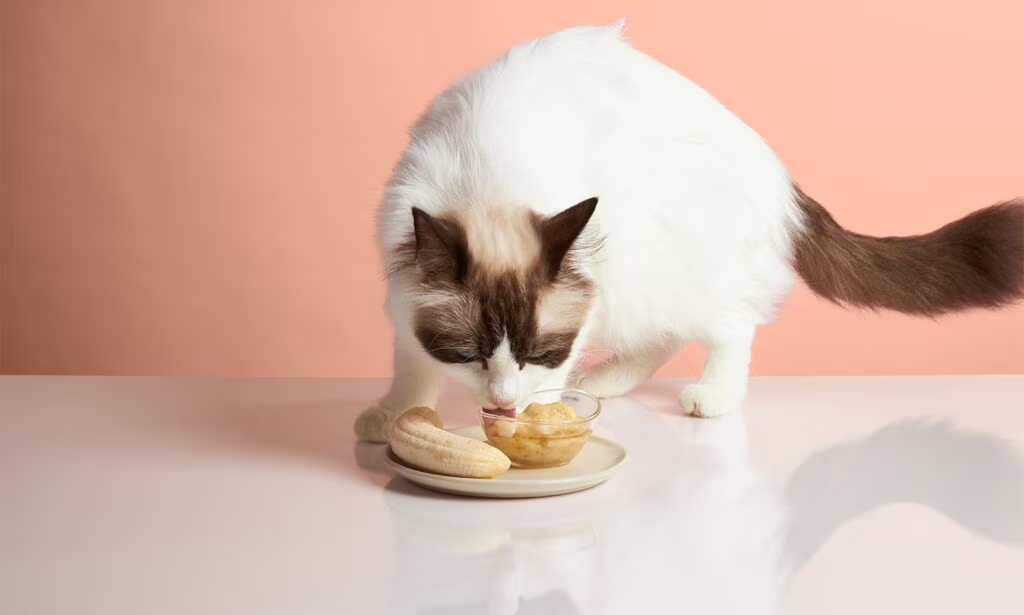Introduction
Cats are naturally curious and often show interest in the foods their owners eat. If you have ever had a banana nearby while your cat was watching, you might have noticed their big eyes and curious nose. This leads to a common question: Can cats eat bananas?
When offered in small portions, bananas are harmless to cats and pose no toxic threat.
Learn more about: Can cats eat peanut butter
But even though they can eat them, it does not always mean they should. Cats have different nutritional needs than humans, and understanding these needs is important for keeping them healthy and happy.
In this guide, we will cover:
- The basic diet needs of cats
- What are bananas made up of nutritionally
- Potential Advantages and Drawbacks of Feeding Bananas to Cats
- Safe ways to feed bananas
- Better treatment options for cats
- By the end, you will know whether and how bananas can fit into your cat’s diet.

Understanding a Cat’s Diet Needs
Before looking at bananas, it is important to understand what a healthy cat needs to eat. Cats are classified as obligate carnivores, which means their nutritional requirements are primarily met through animal-sourced foods. Their digestive system is meant to process animal protein and fat, not plant-based carbohydrates.
Key nutrients that cats get from animal sources include:
- Taurine: An essential amino acid important for heart health, vision, and reproduction.
- Arachidonic acid: A fatty acid that helps with skin, coat, and inflammation.
- Vitamin A: Cats can’t convert plant-based beta-carotene into vitamin A like humans can; they must get it from animal sources like liver or meat.
- High-quality protein: Needed for muscle growth, repair, and overall health.
Since bananas are plant-based and high in carbohydrates, they do not naturally fit into a cat’s biological diet.
Are Bananas Safe for Cats?
Yes, bananas are safe for cats, and a small portion is unlikely to cause harm to a healthy adult feline. However, safe does not mean good for them.
Bananas contain:
- Natural sugars
- Dietary fiber
- Vitamins and minerals such as potassium, vitamin B6, and vitamin C
These can be helpful for people, but are not essential for cats. The biggest issue with giving bananas to cats is their high sugar and carb levels, which felines are not well-equipped to process in large quantities.
Nutritional Profile of Bananas (Per 100g)
- Calories: ~89 kcal
- Carbohydrates: ~23g (12g of which are sugars)
- Fiber: ~2.6g
- Protein: ~1.1g
- Fat: ~0.3g
- Potassium: ~358mg
- Vitamin B6: 0.4mg
- Vitamin C: 8.7mg
These nutrients are good for humans, especially potassium for heart and muscle health, but cats get these from their meat-based diets in a form their bodies can easily use.
Possible Benefits of Bananas for Cats
Even though bananas are not necessary for cats, in very small amounts, they might offer some minor advantages:
- Digestive Aid: The dietary fiber in bananas can promote regular bowel movements and aid overall digestive health. This could help with mild constipation, but too much fiber might cause diarrhea.
- Hydration: Bananas have a high water content. In hot weather, a small piece can contribute to your cat’s fluid intake, though water should be their main source.
- Low-Fat Treat Option: Compared to other fatty snacks, a tiny piece of banana is lower in fat and offers some flavor and texture.
- Enrichment: For cats who enjoy new textures or tastes, a small banana slice can add variety to their treats.
Risks and Concerns of Feeding Bananas to Cats
- High Sugar Content: Cats do not need sugar. Too much can lead to weight gain, obesity, and possibly diabetes over time.
- Digestive Upset: Eating more than a small piece might cause vomiting, diarrhea, or constipation because of the fiber or sugar.
- Choking Risk: The peel of a banana is tough for cats to digest and could lead to choking or intestinal obstruction. Always serve a banana without the peel.
- Allergic Reactions: Though rare, some cats may have sensitivities. Signs include itching, swelling, vomiting, or diarrhea.
- Not for Kittens or Cats with Health Issues: Kittens need a strict diet for growth, and cats with diabetes, obesity, or digestive issues should avoid high-sugar foods.
How to Safely Feed Bananas to Cats
If you decide to give your cat a banana, follow these tips:
- Serve in Tiny Portions: About the size of a fingernail or a small coin.
- Remove the Skin First: Make sure your cat does not bite or ingest the banana peel.
- Give Sparingly: Bananas should only be an occasional snack, limited to once or twice a week.
- Watch for Reactions: Keep an eye on your cat’s appetite, stool, and energy after feeding.
- Make Treats Less than 10% of Diet: This rule applies to all human foods.
Fun Ways to Give Bananas to Cats
- Plain Slice: Offer a fresh, ripe banana piece by hand.
- Mashed Banana Mix: Blend a tiny bit into wet cat food for texture.
- Frozen Banana Treat: Freeze small cubes for a cool summer snack.
- Banana with Catnip: For extra enrichment, mix a banana with a little catnip.
Better Treat Alternatives for Cats
If your goal is to give your cat a safe and beneficial treat, consider these healthier options:
- Cooked chicken or turkey (no seasoning)
- Small bits of cooked salmon or tuna (occasionally)
- Freeze-dried meat treats
- Catnip or cat grass
- Small pieces of blueberries, cantaloupe, or watermelon (in moderation)
Signs Your Cat Should Avoid Bananas
- Your cat has diabetes or is overweight
- They vomit or have diarrhea after eating fruits
- They do not show interest in plant-based foods (many cats ignore bananas)
- They have a known allergy to fruits
FAQs
No, kittens should stick to kitten-formulated food to meet their specific growth needs.
Just a small slice once in a while, no more than 10% of total daily calories from all treats combined.
No. Banana peels are indigestible and can be a choking hazard
Monitor for signs of upset stomach. If vomiting, diarrhea, or lethargy occur, contact your vet.
Conclusion
Bananas are safe but unnecessary for cats. They can be an occasional treat for a healthy adult cat, but they offer little nutritional value compared to meat-based treats. The main risk lies in their sugar and fiber content, which can upset a cat’s stomach and contribute to long-term health issues if overfed.
The best approach? Keep bananas as a rare curiosity rather than a regular snack. Focus on species-appropriate, protein-rich treats that match your cat’s natural dietary needs.
Disclaimer
This article is intended for informational purposes only and should not be taken as veterinary advice. Cats have unique nutritional needs, and while bananas are generally safe in small amounts, they should not replace a balanced, meat-based diet. Always consult your veterinarian before introducing new foods to your cat’s diet.
Author Bio
Atif Mehmood is a pet care writer dedicated to helping cat and dog owners make informed decisions about their pets’ health and nutrition. With a focus on evidence-based research, he creates user-friendly guides that combine veterinary insights with practical tips for everyday pet parenting.
References
Chewy – Can Cats Eat Bananas?
ASPCA – Toxic and Non-Toxic Plants List
PetMD – Cat Nutrition and Diet Guides
International Cat Care – Feeding Your Cat: Nutrition Explained


Pingback: IAMS Cat Food Review: Nutrition, Benefits & Varieties -